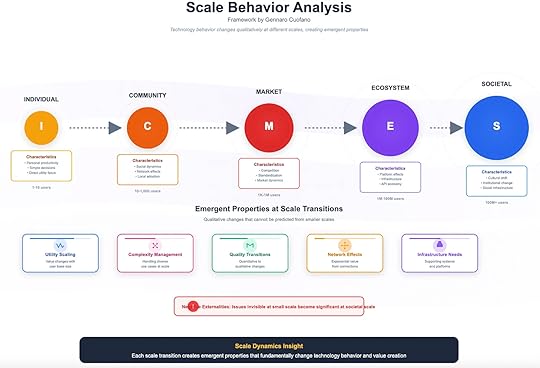Scale Behavior Analysis

Most technologies look simple in their early days. A product that delights ten users can feel like the same product that later serves ten million. But this is an illusion.
As technologies scale, their behavior changes qualitatively, not just quantitatively. Properties emerge that were invisible at small scale—network effects, infrastructure constraints, regulatory shocks, even cultural shifts.
In short: what works for an individual rarely works the same way for society.
The Five Stages of ScaleThe framework breaks adoption into five levels, each with distinct behavioral dynamics:
Individual (1–10 users)Characteristics: personal productivity, simple decisions, direct utility.At this stage, adoption is driven by immediate usefulness.Example: A developer testing ChatGPT as a coding assistant.Community (10–1,000 users)Characteristics: social dynamics, network effects, local adoption.Value is reinforced by peer use—people adopt because friends, colleagues, or niche groups are using it.Example: Slack spreading inside a single startup team.Market (1,000–1M users)Characteristics: competition, standardization, market dynamics.Once in the market phase, rival products appear, standards emerge, and differentiation becomes critical.Example: Zoom’s rise during the pandemic as the market standardized around video calls.Ecosystem (1M–100M users)Characteristics: platform effects, infrastructure needs, API economy.At scale, products stop being standalone and turn into ecosystems. APIs, integrations, and third-party extensions define survival.Example: Shopify’s app ecosystem enabling thousands of complementary services.Societal (100M+ users)Characteristics: cultural shift, institutional change, social infrastructure.At this point, the product is no longer just a business—it is infrastructure, with regulatory oversight and cultural impact.Example: Facebook and TikTok influencing elections, public discourse, and youth culture.Emergent Properties at Scale TransitionsThe leap between these stages is not linear—it is transformative. Several emergent properties kick in:
Utility ScalingValue changes as user base size changes.Example: A messaging app with 10 users is a toy; with 1B users, it’s a utility.Complexity ManagementMore users create more edge cases. Support, moderation, governance become bottlenecks.Example: Twitter struggling with content moderation at global scale.Quality TransitionsSmall changes in adoption trigger qualitative shifts.Example: Wikipedia—once fringe—became the de facto reference point for global knowledge.Network EffectsThe exponential increase in value from connections.Example: LinkedIn becomes indispensable once most professionals are on it.Infrastructure NeedsScaling requires new layers of technical and organizational infrastructure.Example: OpenAI’s massive GPU demand reshaping energy and supply chains.Negative ExternalitiesIssues invisible at small scale become crises at societal scale.Example: Social media algorithms amplifying misinformation only once billions joined.Case Studies in Scale DynamicsUberIndividual/community phase: convenience of pressing a button.Market phase: competition with Lyft, global expansion.Ecosystem phase: driver networks, food delivery, APIs.Societal phase: labor regulation battles and city transport policies.TikTokIndividual: addictive entertainment.Community: teens sharing viral dances.Market: competition with Instagram Reels, YouTube Shorts.Ecosystem: creator economy, ad marketplace.Societal: geopolitical scrutiny, cultural influence on billions.AI Assistants (2023–2025)Individual: productivity boost for knowledge workers.Community: rapid adoption across developer and creative teams.Market: competition between OpenAI, Anthropic, Google, Meta.Ecosystem: API-driven workflows, enterprise integrations.Societal: national AI strategies, energy demands, geopolitical tensions.The Strategic ImplicationFor founders, policymakers, and strategists, the core insight is this: every scale transition is a phase shift.
At the individual level, focus on direct utility.At the community level, design for social reinforcement.At the market level, prepare for commoditization and differentiation.At the ecosystem level, build infrastructure and developer networks.At the societal level, expect regulation, cultural responsibility, and political battles.The mistake most leaders make is extrapolating early adoption patterns into later stages. What worked at 10,000 users often collapses at 10 million.
ConclusionTechnology does not scale smoothly—it mutates at every order of magnitude.
The jump from individual to community is about social adoption.The jump from community to market is about competition.The jump from market to ecosystem is about infrastructure.The jump from ecosystem to societal is about governance and culture.The companies that thrive are those that anticipate these mutations and re-architect themselves accordingly.
Scale is not just growth—it is transformation.

The post Scale Behavior Analysis appeared first on FourWeekMBA.



